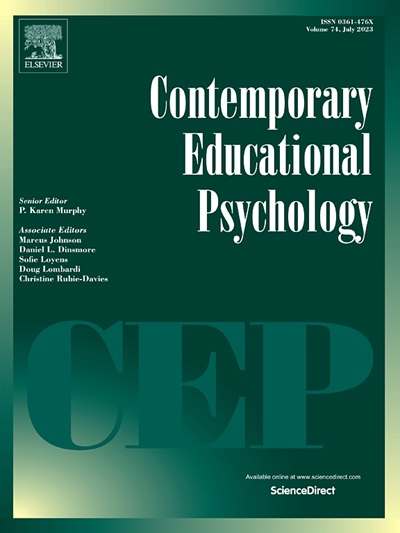如何在计算机评估中加强详细反馈:多媒体和情感设计因素的作用
IF 3.8
1区 心理学
Q1 PSYCHOLOGY, EDUCATIONAL
引用次数: 0
摘要
基于计算机的反馈内容的影响在文献中受到了广泛的关注。相比之下,反馈信息中视觉设计特征的影响尚未得到充分研究。本实验考察了在基于计算机的低风险评估中,在详细的反馈中添加代表性图片和/或信息性情感设计元素的认知和情感益处。在一项2x2 + 1受试者之间的研究中,410名本科生参与了一项几何评估,在不同的设计变化中,他们要么没有收到反馈(对照组),要么收到即时的、详细的反馈信息:我们系统地改变了代表性图片(没有/有)和情感设计特征(没有/有)的存在。与无反馈相比,四种反馈变体在正确反应后增强了积极情绪,减少了消极情绪,但在错误反应后减少了积极情绪,增强了消极情绪。所有的反馈变体都有效地增强了学生在后测中的错误纠正(即回忆最初错误的回答),所有反馈组的学生在错误回答后自愿花更多的时间来详细阐述反馈信息。然而,花在反馈信息上的时间并没有受到设计特性的显著影响。这种结果模式表明,学生积极地处理了负面反馈,而不受其设计的影响。然而,与纯文字反馈相比,当反馈涉及错误时(即在错误的回答之后),仅添加图片提高了学生报告的积极情绪水平。总的来说,我们的研究结果表明,图片可以作为情感促进者,可以增强文本反馈信息,以减轻自动错误通知的负面情感影响。本文章由计算机程序翻译,如有差异,请以英文原文为准。
How to enhance elaborated feedback in computer-based assessment: The role of multimedia and emotional design factors
Effects of computer-based feedback content have received much attention in the literature. In contrast, the effects of visual design features in feedback messages are understudied. This experiment examined the cognitive and the emotional benefit of adding a representational picture and/or informative emotional design elements to elaborated feedback in a computer-based low-stakes assessment. In a 2x2 + 1 between-subjects study, 410 undergraduates worked on a geometry assessment receiving either no feedback (control group) vs. immediate, elaborated feedback messages in different design variations: We systematically varied the presence of a representational picture (without/with) and of emotional design features (without/with). Compared to no feedback, the four feedback variants enhanced positive emotions and reduced negative emotions after correct responses but reduced positive emotions and enhanced negative emotions after incorrect responses. All feedback variants effectively enhanced students’ error correction in a posttest (i.e., recall on initially incorrect responses) and students across all feedback groups voluntarily spent longer time on elaborated feedback messages after incorrect responses. Yet, the time spent on the feedback messages was not significantly affected by the design features. This pattern of results suggests that students actively processed the negative feedback, independent of its design. However, compared to text-only feedback, only adding a picture improved students’ reported level of positive emotions when the feedback referred to a mistake (i.e., after incorrect responses). Overall, our results indicate that pictures can serve as emotional facilitators and could enhance text-only feedback messages to mitigate a negative affective impact of automated error notifications.
求助全文
通过发布文献求助,成功后即可免费获取论文全文。
去求助
来源期刊

Contemporary Educational Psychology
PSYCHOLOGY, EDUCATIONAL-
CiteScore
16.50
自引率
3.90%
发文量
74
期刊介绍:
Contemporary Educational Psychology is a scholarly journal that publishes empirical research from various parts of the world. The research aims to substantially advance, extend, or re-envision the ongoing discourse in educational psychology research and practice. To be considered for publication, manuscripts must be well-grounded in a comprehensive theoretical and empirical framework. This framework should raise critical and timely questions that educational psychology currently faces. Additionally, the questions asked should be closely related to the chosen methodological approach, and the authors should provide actionable implications for education research and practice. The journal seeks to publish manuscripts that offer cutting-edge theoretical and methodological perspectives on critical and timely education questions.
The journal is abstracted and indexed in various databases, including Contents Pages in Education, Australian Educational Index, Current Contents, EBSCOhost, Education Index, ERA, PsycINFO, Sociology of Education Abstracts, PubMed/Medline, BIOSIS Previews, and others.
 求助内容:
求助内容: 应助结果提醒方式:
应助结果提醒方式:


